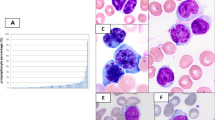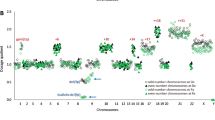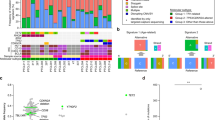Abstract
The poor prognosis of chronic lymphocytic leukemia (CLL) patients with del (17p) is well established. We analyzed whether mutation of TP53 on the remaining allele adds to the poor prognosis or whether even TP53 mutation alone may be an adverse prognostic factor. We analyzed TP53 mutations in 193 CLL patients by denaturing high performance liquid chromatography in combination with direct DNA sequencing and a TP53 resequencing research microarray. Mutations were correlated to chromosomal aberrations defined by interphase fluorescent in situ hybridization and chromosome banding analyses and to the clinical course of patients. TP53 mutations were detected in 13.5% (26 of 193) of samples, whereas the incidence of del (17p) was 9.3% (18 of 193). TP53 mutations were significantly associated with del (17p) (concordance 94%, P<0.001) and complex cytogenetic abnormalities (concordance 50%, P<0.001). Among 147 patients whose clinical data were available, patients with TP53 abnormalities (n=20) had a significantly decreased time to treatment compared to patients without TP53 aberration (P<0.001). Median time to treatment was short in patients with isolated TP53 mutation (n=6, 2.0 months) and in those with del (17p) (n=14, 21.3 months) as compared to patients without TP53 aberration (n=127, 64.9 months, P<0.001). In multivariate Cox regression analysis, VH status, TP53 mutations and also isolated TP53 mutations independently predicted rapid disease progression.
This is a preview of subscription content, access via your institution
Access options
Subscribe to this journal
Receive 12 print issues and online access
$259.00 per year
only $21.58 per issue
Buy this article
- Purchase on Springer Link
- Instant access to full article PDF
Prices may be subject to local taxes which are calculated during checkout



Similar content being viewed by others
References
Chiorazzi N, Rai KR, Ferrarini M . Chronic lymphocytic leukemia. N Engl J Med 2005; 352: 804–815.
Seiler T, Dohner H, Stilgenbauer S . Risk stratification in chronic lymphocytic leukemia. Semin Oncol 2006; 33: 186–194.
Dohner H, Stilgenbauer S, Benner A, Leupolt E, Krober A, Bullinger L et al. Genomic aberrations and survival in chronic lymphocytic leukemia. N Engl J Med 2000; 343: 1910–1916.
Isobe M, Emanuel BS, Givol D, Oren M, Croce CM . Localization of gene for human p53 tumour antigen to band 17p13. Nature 1986; 320: 84–85.
Vogelstein B, Lane D, Levine AJ . Surfing the p53 network. Nature 2000; 408: 307–310.
Oscier DG . Cytogenetic and molecular abnormalities in chronic lymphocytic leukaemia. Blood Rev 1994; 8: 88–97.
Dohner H, Fischer K, Bentz M, Hansen K, Benner A, Cabot G et al. p53 gene deletion predicts for poor survival and non-response to therapy with purine analogs in chronic B-cell leukemias. Blood 1995; 85: 1580–1589.
Byrd JC, Gribben JG, Peterson BL, Grever MR, Lozanski G, Lucas DM et al. Select high-risk genetic features predict earlier progression following chemoimmunotherapy with fludarabine and rituximab in chronic lymphocytic leukemia: justification for risk-adapted therapy. J Clin Oncol 2006; 24: 437–443.
Wattel E, Preudhomme C, Hecquet B, Vanrumbeke M, Quesnel B, Dervite I et al. p53 mutations are associated with resistance to chemotherapy and short survival in hematologic malignancies. Blood 1994; 84: 3148–3157.
Grever MR, Lucas DM, Dewald GW, Neuberg DS, Reed JC, Kitada S et al. Comprehensive assessment of genetic and molecular features predicting outcome in patients with chronic lymphocytic leukemia: results from the US Intergroup Phase III Trial E2997. J Clin Oncol 2007; 25: 799–804.
Fenaux P, Preudhomme C, Lai JL, Quiquandon I, Jonveaux P, Vanrumbeke M et al. Mutations of the p53 gene in B-cell chronic lymphocytic leukemia: a report on 39 cases with cytogenetic analysis. Leukemia 1992; 6: 246–250.
Lepelley P, Preudhomme C, Vanrumbeke M, Quesnel B, Cosson A, Fenaux P . Detection of p53 mutations in hematological malignancies: comparison between immunocytochemistry and DNA analysis. Leukemia 1994; 8: 1342–1349.
El Rouby S, Thomas A, Costin D, Rosenberg CR, Potmesil M, Silber R et al. p53 gene mutation in B-cell chronic lymphocytic leukemia is associated with drug resistance and is independent of MDR1/MDR3 gene expression. Blood 1993; 82: 3452–3459.
Zenz T, Krober A, Scherer K, Häbe S, Buhler A, Benner A et al. Mono-allelic TP53 inactivation is associated with poor prognosis in CLL: Results from a detailed genetic characterization with long term follow-up. Blood 2008, published online 8 August 2008.
Pettitt AR, Sherrington PD, Stewart G, Cawley JC, Taylor AM, Stankovic T . p53 dysfunction in B-cell chronic lymphocytic leukemia: inactivation of ATM as an alternative to TP53 mutation. Blood 2001; 98: 814–822.
Trbusek M, Malcikova J, Smardova J, Kuhrova V, Mentzlova D, Francova H et al. Inactivation of p53 and deletion of ATM in B-CLL patients in relation to IgVH mutation status and previous treatment. Leukemia 2006; 20: 1159–1161.
Hamelin R, Jego N, Laurent-Puig P, Vidaud M, Thomas G . Efficient screening of p53 mutations by denaturing gradient gel electrophoresis in colorectal tumors. Oncogene 1993; 8: 2213–2220.
Carter A, Lin K, Sherrington PD, Pettitt AR . Detection of p53 dysfunction by flow cytometry in chronic lymphocytic leukaemia. Br J Haematol 2004; 127: 425–428.
Cordone I, Masi S, Mauro FR, Soddu S, Morsilli O, Valentini T et al. p53 expression in B-cell chronic lymphocytic leukemia: a marker of disease progression and poor prognosis. Blood 1998; 91: 4342–4349.
Cheson BD, Bennett JM, Grever M, Kay N, Keating MJ, O'Brien S et al. National Cancer Institute-sponsored Working Group guidelines for chronic lymphocytic leukemia: revised guidelines for diagnosis and treatment. Blood 1996; 87: 4990–4997.
Hallek M, Cheson BD, Catovsky D, Caligaris-Cappio F, Dighiero G, Dohner H et al. Guidelines for the diagnosis and treatment of chronic lymphocytic leukemia: a report from the international workshop on chronic lymphocytic leukemia updating the national cancer institute-working group 1996 guidelines. Blood 2008; 111: 5446–5456.
Dicker F, Schnittger S, Haferlach T, Kern W, Schoch C . Immunostimulatory oligonucleotide-induced metaphase cytogenetics detect chromosomal aberrations in 80% of CLL patients: a Study of 132 CLL cases with correlation to FISH, IgVH status, and CD38 expression. Blood 2006; 108: 3152–3160.
Haferlach C, Dicker F, Schnittger S, Kern W, Haferlach T . Comprehensive genetic characterization of CLL: a study on 506 cases analysed with chromosome banding analysis, interphase FISH, IgV(H) status and immunophenotyping. Leukemia 2007; 21: 2442–2451.
ISCN. In: Mitelman F (edn). ISCN 1995, Guidelines for Cancer Cytogenetics, Supplement to: An International System for Human Cytogenetic Nomenclature. S. Karger: Basel, 1995, 1–110.
Hamblin TJ, Davis Z, Gardiner A, Oscier DG, Stevenson FK . Unmutated Ig V(H) genes are associated with a more aggressive form of chronic lymphocytic leukemia. Blood 1999; 94: 1848–1854.
Damle RN, Wasil T, Fais F, Ghiotto F, Valetto A, Allen SL et al. Ig V gene mutation status and CD38 expression as novel prognostic indicators in chronic lymphocytic leukemia. Blood 1999; 94: 1840–1847.
Mayr C, Speicher MR, Kofler DM, Buhmann R, Strehl J, Busch R et al. Chromosomal translocations are associated with poor prognosis in chronic lymphocytic leukemia. Blood 2006; 107: 742–751.
Krober A, Seiler T, Benner A, Bullinger L, Bruckle E, Lichter P et al. V(H) mutation status, CD38 expression level, genomic aberrations, and survival in chronic lymphocytic leukemia. Blood 2002; 100: 1410–1416.
Sturm I, Bosanquet AG, Hermann S, Guner D, Dorken B, Daniel PT . Mutation of p53 and consecutive selective drug resistance in B-CLL occurs as a consequence of prior DNA-damaging chemotherapy. Cell Death Differ 2003; 10: 477–484.
Maloum K, Davi F, Merle-Beral H, Pritsch O, Magnac C, Vuillier F et al. Expression of unmutated VH genes is a detrimental prognostic factor in chronic lymphocytic leukemia. Blood 2000; 96: 377–379.
Jones AC, Austin J, Hansen N, Hoogendoorn B, Oefner PJ, Cheadle JP et al. Optimal temperature selection for mutation detection by denaturing HPLC and comparison to single-stranded conformation polymorphism and heteroduplex analysis. Clin Chem 1999; 45 (8 Part 1): 1133–1140.
Greiner TC . Enhanced detection of TP53 mutations using a GC-clamp in denaturing high performance liquid chromatography. Diagn Mol Pathol 2007; 16: 32–37.
Zenz T, Trbusek M, Smardova J, Häbe S, Denzel T, Malcikova J et al. p53 Inactivation in CLL: pattern of 110 TP53 mutations [abstract]. Blood 2007; 110: 615a.
Petitjean A, Mathe E, Kato S, Ishioka C, Tavtigian SV, Hainaut P et al. Impact of mutant p53 functional properties on TP53 mutation patterns and tumor phenotype: lessons from recent developments in the IARC TP53 database. Hum Mutat 2007; 28: 622–629.
Sigal A, Rotter V . Oncogenic mutations of the p53 tumor suppressor: the demons of the guardian of the genome. Cancer Res 2000; 60: 6788–6793.
Chene P . The role of tetramerization in p53 function. Oncogene 2001; 20: 2611–2617.
Campomenosi P, Monti P, Aprile A, Abbondandolo A, Frebourg T, Gold B et al. p53 mutants can often transactivate promoters containing a p21 but not Bax or PIG3 responsive elements. Oncogene 2001; 20: 3573–3579.
Dittmer D, Pati S, Zambetti G, Chu S, Teresky AK, Moore M et al. Gain of function mutations in p53. Nat Genet 1993; 4: 42–46.
Lozanski G, Heerema NA, Flinn IW, Smith L, Harbison J, Webb J et al. Alemtuzumab is an effective therapy for chronic lymphocytic leukemia with p53 mutations and deletions. Blood 2004; 103: 3278–3281.
Dreger P, Brand R, Michallet M . Autologous stem cell transplantation for chronic lymphocytic leukemia. Semin Hematol 2007; 44: 246–251.
Fink SR, Smoley SA, Stockero KJ, Paternoster SF, Thorland EC, Van Dyke DL et al. Loss of TP53 is due to rearrangements involving chromosome region 17p10 approximately p12 in chronic lymphocytic leukemia. Cancer Genet Cytogenet 2006; 167: 177–181.
Oscier DG, Gardiner AC, Mould SJ, Glide S, Davis ZA, Ibbotson RE et al. Multivariate analysis of prognostic factors in CLL: clinical stage, IGVH gene mutational status, and loss or mutation of the p53 gene are independent prognostic factors. Blood 2002; 100: 1177–1184.
Lengauer C, Kinzler KW, Vogelstein B . Genetic instabilities in human cancers. Nature 1998; 396: 643–649.
Paulovich AG, Toczyski DP, Hartwell LH . When checkpoints fail. Cell 1997; 88: 315–321.
Shrivastav M, De Haro LP, Nickoloff JA . Regulation of DNA double-strand break repair pathway choice. Cell Res 2008; 18: 134–147.
Coll-Mulet L, Iglesias-Serret D, Santidrian AF, Cosialls AM, de Frias M, Castano E et al. MDM2 antagonists activate p53 and synergize with genotoxic drugs in B-cell chronic lymphocytic leukemia cells. Blood 2006; 107: 4109–4114.
Author information
Authors and Affiliations
Corresponding author
Additional information
Supplementary Information accompanies the paper on the Leukemia website (http://www.nature.com/leu)
Supplementary information
Rights and permissions
About this article
Cite this article
Dicker, F., Herholz, H., Schnittger, S. et al. The detection of TP53 mutations in chronic lymphocytic leukemia independently predicts rapid disease progression and is highly correlated with a complex aberrant karyotype. Leukemia 23, 117–124 (2009). https://doi.org/10.1038/leu.2008.274
Received:
Revised:
Accepted:
Published:
Issue Date:
DOI: https://doi.org/10.1038/leu.2008.274
Keywords
This article is cited by
-
Different impacts of TP53 mutations on cell cycle-related gene expression among cancer types
Scientific Reports (2023)
-
Clonal evolution in chronic lymphocytic leukemia is associated with an unmutated IGHV status and frequently leads to a combination of loss of TP53 and TP53 mutation
Molecular Biology Reports (2022)
-
The impact of complex karyotype on the overall survival of patients with relapsed chronic lymphocytic leukemia treated with idelalisib plus rituximab
Leukemia (2020)
-
Time to first treatment and P53 dysfunction in chronic lymphocytic leukaemia: results of the O-CLL1 study in early stage patients
Scientific Reports (2020)
-
Idelalisib addition has neutral to beneficial effects on quality of life in bendamustine/rituximab-treated patients: results of a phase 3, randomized, controlled trial
Health and Quality of Life Outcomes (2019)



